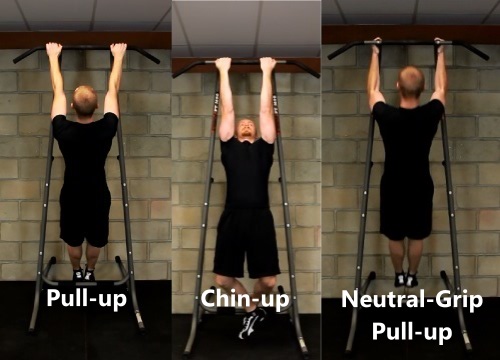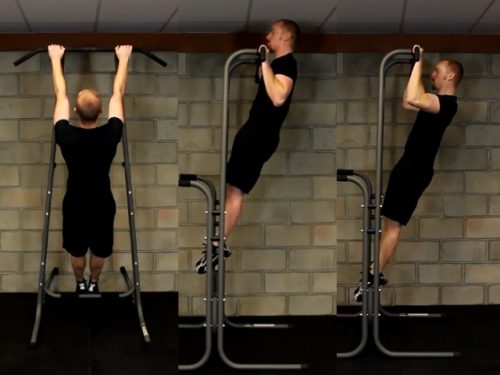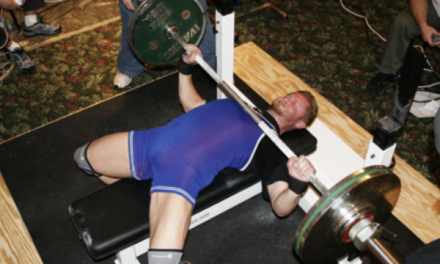Pull-ups and chin-ups are a couple of the best upper body exercises for strength and muscle building. They help build and strengthen your back, biceps, forearms, shoulders, and core. They can also help restore mobility and function at your shoulders, balance out your upper body muscle development, and even improve your posture, among other benefits.
Bodybuilders swear by them for back and bicep development, and powerlifters use them to balance out their bench pressing, among other things. Most experts agree that if you do any strength training, and especially if you bench press often, you should also be doing pull-ups regularly.
Now, pull-ups and chin-ups deliver a lot of benefits, but they are really hard! And many people – even those with a lot of training experience – struggle to do even one proper rep.

So, in this article, I’ll give you five ways to do more pull-ups – whether you’re trying to get your first deadhang pull-up with proper form, or trying to break a plateau to hit 10-20 reps, or more.
If you put these ideas to use, you’ll be doing more pull-ups sooner than you think.
1. Train pull-ups as often as you can, but not too hard, and never to muscle failure.
Whether you can do zero pull-ups or more than twenty reps, the fastest way to get better at them is to practice as frequently as possible at a moderate intensity, which is why the Grease The Groove method is a perfect fit for the pull-up trainee.
Here’s how to Grease The Groove to improve your pull-ups.
• Perform a moderate intensity set of pull-ups several times per day, several days per week (having access to a pull-up bar or another place to do your reps throughout the day is a must)
• Pick a repetition amount that falls between 40-80% of your maximum reps (e.g. if you can do 10 pull-ups, do sets of 4-8 reps)
• Do at least 3-5 sets, and up to 10 or more total sets throughout the day
• Allow plenty of rest between sets (e.g. 15-60+ minutes)
• Avoid muscle failure and don’t train to exhaustion
• Train as often as you can fully recover, at least 4 and no more than 6 days per week
• Increase the number of pull-ups you complete every day you train to increase your total training volume each week (i.e. do slightly more sets and/or reps every workout)
In other words: frequent, gradually-progressive practice, at a sub-maximal intensity, and always with proper form. This is a perfect formula for rapid, short-term results. And it’s why many people are able to dramatically increase their pull-ups and chin-ups with the Grease The Groove method.
2. Match your pull-up exercises to your unique needs, goals and conditioning level.
First, you’ll want to decide if you’d like to focus on pull-ups, chin-ups, or neutral-grip pull-ups. Each variation has it’s own pros and cons. Pull-ups focus more on the lats (i.e. back), while chin-ups focus more on the biceps (i.e. arms). Neutral-grip pull-ups recruit more overall musculature and are also easier on the shoulders. So, choose the one that makes the most sense or that is easiest for you to perform. And remember, that you can and should make changes for variety in the future.

Also, generally speaking, you’ll want to focus on the most advanced pull-up exercise that you can perform with good technique. So, if you can do strict, deadhang pull-ups with good technique, you should. But if you can’t, you should do the closest progression you can manage.
How to work up to your first pull-up
Train with the following exercises to help work up to standard pull-ups:
Step 1) Dead Hangs – Hold the bottom, hanging position with elbows locked and shoulders packed for time. This exercise is great for people who have trouble with the bottom range of motion (i.e. starting the pull-up).
Step 2) Flexed-Arm Hangs – Hold the top position for time with your chin over the bar and elbows in tight. This exercise is great for those who struggle to get their chin over the bar.
Step 3) Negative Pull-ups – Perform only the eccentric portion of the exercise (i.e. just lowering yourself down, under control). Negative reps are a great strategy for both building muscle and increasing reps – for beginners and advanced trainees alike.
Step 4) Assisted Pull-ups – You can perform assisted pull-ups and chin-ups by
- using a resistance band to support some of your weight
- using a step or bench to push off from with your feet
- jumping just enough to help get your chin over the bar
- having a partner help you complete your reps by pushing on your mid-back or supporting your ankles
By choosing the best pull-up exercises for your goals and conditioning level, you’ll find the “sweet spot” to maximize your results.
3. Use targeted strategies to boost results.
There are many helpful techniques to improve your results. Here are a handful of them.
Drop Sets – Do a set of pull-ups, then immediately (i.e. without resting) perform a set of assisted pull-ups, then immediately perform a set of negative pull-ups, then immediately hold a flexed arm hang, then immediately perform a deadhang.
Rest Pauses – After you’ve finished a set of pull-ups (e.g. usually your last set for the day), rest for 5-10 seconds and then perform another set. Continue until you can no longer perform any reps with proper form after resting for 10 seconds.
Isometrics – Hold a specific position in the pull-up exercise that gives you trouble for time (e.g. top, middle, or bottom position), such as with the flexed-arm hang and deadhang exercises.

Partial Reps – If you have trouble getting out of the bottom position or into the top position, do partial reps to strengthen that specific range of motion.
Multiple grips – By varying your grips on the pull-up bar, you’ll target different areas of your muscles and train them in different ways, which will result in more well-rounded strength and balanced muscle development.
4. Train with the Big 3 pull-up workouts.
If you look at almost every pull-ups workout program, you’re going to find a few different kinds of workouts that are usually included. It’s because they’re simple and they work.
So, a good basic pull-up workout program would be to do the following three workouts on non-consecutive days every week (e.g. Monday, Wednesday, Friday). There are more effective programs, of course. But a simple program like this, done with a high level of effort, can product great results.
Pull-up Workout 1 (Monday) – Pull-up Ladder Workouts
Instructions: Do one pull-up, then rest for about 10 seconds. Do two pull-ups, then rest for about 20 seconds. And continue this progression until you max out and can’t complete the next level. Then work your way back down the ladder by doing one less repetition each set.
For example:
Set 1: 1 rep
Set 2: 2 reps
Set 3: 3 reps
Set 4: 4 reps
Set 5: 5 reps
Set 6: 5 reps (max – missed 6th rep)
Set 7: 4 reps
Set 8: 3 reps
Set 9: 2 reps
Set 10: 1 rep
Pull-up Workout 2 (Wednesday) – Pull-ups Max Effort Workout
Instructions: After a warmup, complete 3-5 max or near-max sets of pull-ups, gradually increasing your intensity each set. Rest 2-3 minutes between sets.
For example:
Set 1: 80% of max reps
Set 2: 85% of max reps
Set 3: 90% of max reps
Set 4: 95% of max reps
Set 5: 100% of max reps
Pull-up Workout 3 (Friday) – Pull-ups Endurance Workout
Instructions: Select a repetition number that’s approximately half of your maximum ability. So, if you can do 10 pull-ups during a test, your number is 5 reps. Complete 10-20 sets, resting no more than 30 seconds between sets.
For example:
Set 1: 5 reps
Set 2: 5 reps
Set 3: 5 reps
Set 4: 5 reps
Set 5: 5 reps
Set 6: 5 reps
Set 7: 5 reps
Set 8: 5 reps
Set 9: 5 reps
Set 10: 5 reps
These three pull-up workouts are simple and brutal, and will quickly help you increase your pull-up numbers.

5. Tweak your technique to maximize strength and performance.
You’d be surprised how many people increase their pull-up strength and performance instantly by simply making changes to their technique. A small adjustment in your hand positioning, or finally learning how to recruit your lats or activate your core can increase your reps immediately.
So, make sure you’re using proper form that draws on the strength of your entire body – not just your back and bicep muscles. In other words, stop doing sloppy, mindless pull-ups.
8 Tips to Correct Common Pull-up and Chin-up Mistakes
Instant improvements are often made by correcting the following mistakes:
-
- Wrap your thumbs around the bar on the same side as your fingers (instead of opposite your fingers)
-
- Place your hands slightly outside of shoulder width on the bar
-
- Maintain a straight (i.e. neutral) wrist while hanging from the pull-up bar (do not over-flex your wrists)
-
- Initiate each rep by retracting your shoulders down onto your torso (i.e. stabilizing them) and keep them packed down throughout the full range of motion
-
- Keep your elbows in tight alongside your ribs instead of flared out to the sides
-
- Activate your core with a strong exhale during the concentric portion of the exercise (i.e. pulling yourself up), and inhale passively as you lower back down
-
- Squeeze your glutes and thighs hard during each rep
- Lengthen your spine by lifting with the crown of your head (i.e. instead of reaching with your chin) and tucking your tailbone slightly
Here’s a video that will walk you through the finer details of optimal pull-up technique. Even if you’re been doing pull-ups for a long time, I think you’ll learn some new things from this video. Once you’ve gotten your form honed in, pull-ups get a lot easier.
There’s no secret to getting better at pull-ups.
You’ve just have to train smart and put in the work. If you’re consistent, you should start seeing results within 1-2 weeks. And many people are amazed at how much they can boost their reps after just a month of focused training.
So, if YOU would like to dominate the pull-up bar, put some of these ideas into action today, and get started on a good program ASAP.
Want to do More Pull-ups?
Click Here to Learn How To Rapidly Increase Your Pull-up & Chin-up Numbers In 3 Months Or Less
About the Author
John Sifferman is a health-first fitness coach and the author of The Pull-up Solution: The Complete Pull-up and Chin-up Training System, which helps people rapidly increase their pull-up numbers in three months or less. You can learn how John dramatically improved his pull-up performance and has helped thousands of people do the same with a unique twist on pull-up training at his website www.ThePullupSolution.com.











